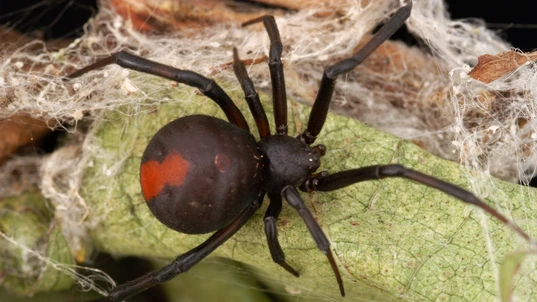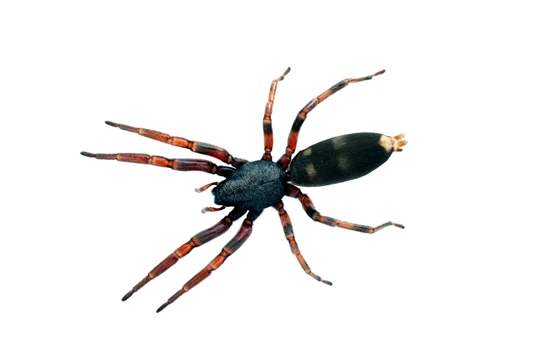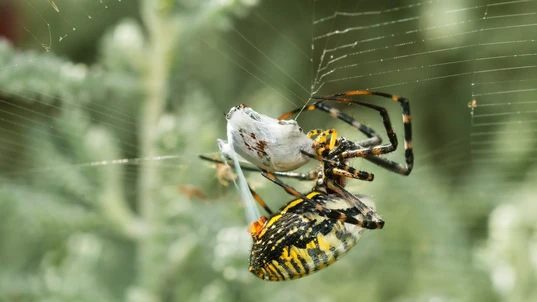4 Easy Tips to Control Spider Numbers Around Your Home

Bites and Stings

There are several spider species in Australia that like building their nests in and around the family home. Use these 4 simple tricks to keep their population numbers under control.
According to the Commonwealth Scientific and Industrial Research Organisation (CSIRO), Australia is home to roughly 2,700 spider species that inhabit a range of both natural and urban environments. As scary as spider bites may seem, only 2 Australian spider species have killed people in the past (the Redback and the Funnel-web), and the last confirmed death from a spider bite occurred way back in 1979. Nevertheless, every Australian spider species contains some type of venom, which can cause a host of nasty symptoms that may require medical attention, especially in young children and pregnant women. Though the thought of spiders living in and around your home is probably not appealing, the thought of killing them en masse is likely not too palatable, either. Luckily, there are several steps you can take to rid your home of spiders without killing them. Let’s get into it!Common Australian Spiders
Before we outline the steps to make your home spider-proof, it’s worthwhile looking at the spiders you are likely sharing your home and garden with. That way, if you do manage to sustain a spider bite, you will know exactly how to treat it.
Daddy-long-legs spiders are one of the most common spiders in Australia. In fact, Daddy-long-legs spiders can be found in every continent across the globe, except for Antarctica.
Daddy-long-legs Spider
Daddy-long-legs spiders are so named because of their incredibly lengthy limbs, which are approximately five times longer than their bodies. Their bodies are generally 6 to 8 millimetres (mm) in length and cream to pale brown in colour. In the outdoors, they like to live in dark, damp areas like abandoned burrows. Inside the family home, meanwhile, they prefer quiet, undisturbed areas like corners, attics, and cellars. Daddy-long-legs spiders are a passive bunch, and their venom generally only causes a short-lived stinging or burning sensation that can be treated with a cold compress. You should seek medical attention if you experience anaphylaxis or if your symptoms get worse instead of better.
Redback spiders are considered native to Australia, and they can be found in any location where there is sufficient food, shelter, and warmth. Unlike females, male Redback spiders are usually brown in colour with white or yellow markings.
Redback Spider
Female Redback spiders tend to be black in colour and have a brilliant orange to red stripe on the top of their abdomen, hence their name. Females also tend to be 1 centimetre (cm) in size, while their male counterparts tend to max out at a modest 5 mm. Redback spiders have a predilection for dry, sheltered sites, and they typically set up their webs close to human habitation in sheds, toilets, and under rocks and junk piles. Only female Redback spiders are capable of biting humans, though this usually occurs when they are inadvertently dislodged from their webs. Redback spider venom is highly neurotoxic and often causes pain, redness, and swelling at the bite site. Use the following first aid procedure for Redback spider bites:- Reassure the casualty and keep them under constant observation.
- Apply a cold compress to the bite site for periods of up to 20 minutes to lessen the pain.
- If the casualty is a young child (under 8 years), a pregnant woman, or if they exhibit any signs of anaphylaxis or deterioration, follow the basic life support guidelines per DRSABCD and call Triple Zero (000) for an ambulance.
- DO NOT use the Pressure Immobilisation Technique, as the venom moves slowly and this will just worsen the pain.

The White tail spider is native to Australia and New Guinea. The two most common species of White tail are Lampona cylindrata and Lampona murina, which can be found across southern and eastern Australia, respectively.
White Tail Spider
White tail spiders get their name from two small white spots that appear at the rearmost tip of their abdomen. Their cigar-shaped body generally grows up to 18 mm in length and is grey to dark reddish in colour. In the outdoors, White tail spiders tend to live beneath bark, rocks, and leaf litter. White tail spiders living indoors, however, are typically found between folds of fabric like clothing, bedding, and towels. White tail spiders generally only bite humans when they are startled, and though their venom has long been associated with necrotic arachnidism, it largely only causes symptoms synonymous with those of a bee sting, such as localised burning, swelling, and discolouration. The first aid procedure for a White tail spider bite is the same as that for a Redback spider bite.
Australia's most common species of Wolf spider, the Garden wolf spider, can be found in open woodlands and suburban backyards, where they feed on crickets, ants, and other ground-dwelling invertebrates.
Wolf Spider
Much like actual wolves, Wolf spiders have excellent agility and eyesight that allows them to run down prey in the dead of night. Wolf spiders are also relatively hairy and drab in colour with variegated patterns of grey, brown, or black markings. Though Wolf spiders can occupy a range of coastal and inland habits, they are most often encountered in the humble suburban backyard, where they like to build burrows. Wolf spiders prefer to run away from trouble and will only bite when threatened. Likewise, their venom usually only causes mild symptoms like localised pain or itchiness. The first aid procedure for a Wolf spider bite is that same as that for a Redback spider bite.
There are over 100 known species of Garden orb weaving spider scattered across Australia. They are a common backyard spider, and though they are present all season, their lifespan is a mere 12 months.
Garden Orb Weaving Spider
Garden orb weaving spiders are widely renowned for building large, intricate ‘orb’ shaped webs to catch flying insects. They tend to be grey to reddish brown in colour and only grow 15 to 20 mm in length, as their abdomen is quite bulbous. Australia’s most common species of Garden orb weaving spiders are generally found in southern and eastern parts of the country, where they suspend their webs between trees and shrubs to catch flies, beetles, and cicadas. Like most of the spiders mentioned in this article, Garden orb weaving spiders tend to be shy and will only bite when provoked. Their venom, likewise, typically only causes mild pain and swelling at the bite site. The first aid procedure for a Garden orb weaving spider is the same as that for a Redback spider bite.How to Control Local Spider Populations
Now that we’ve covered the spiders you are likely to encounter in and around the home, let’s look at how to spider proof your home humanely.1. Declutter Your Home
Several of the spiders mentioned in this article, as well as the Brown recluse spider, like setting up their nests in dark and undisturbed areas – for instance, in between folds of fabric and underneath log piles and pieces of furniture. As such, you can reduce your local spider populations by ridding your home of excess and seldom used clutter, which will eliminate the number of dark, undisturbed areas they can use to build nests. Regularly dusting and cleaning your home will also help reduce local spider populations, as spiders like dusty areas where they know their nests and eggs will remain out of harm’s way.2. Seal Up Your Home
As we mentioned earlier, many spiders migrate indoors as the weather heats up. They can enter the home through a variety of discrete access points, such as cracks in window frames, underneath doors, and between gaps in the walls. Replacing torn window screens and installing felt rolls or other sealing options at the bottom of your doors will make it difficult for spiders to make their usual spring/summer migration.3. Turn Off the Lights
Common indoor spiders like the Black house spider like building their webs close to light sources, as light sources attract ideal spider prey like moths, beetles, and termites. You can reduce your local spider populations by turning off light sources when you aren’t using them, as this will stop insects from gathering and force the spiders to hunt elsewhere.4. Apply a Natural Insecticide
Spiders have a strong sense of smell, which they use to find a mate and to distinguish between edible and inedible objects. Consequently, they are averse to strong odours like peppermint, cinnamon, and vinegar. As such, you can reduce your local spider populations by spritzing spider-affected areas with a mixture of water and peppermint oil, or any other potent natural oil.Final Thoughts
Though most Australian spiders are not capable of killing humans, they do contain venom that can cause uncomfortable symptoms like pain, swelling, and nausea. They can also cause dangerous symptoms in the immunocompromised, such as young children and pregnant women. With this in mind, it is important to keep your local spider populations in check. There are several humane ways you can do this - for instance, by decluttering and sealing up your home, as well as spritzing it with a natural insecticide like peppermint or eucalyptus oil. It is important to note, despite your best spider-proofing efforts, you may one day find yourself on the wrong end of a spider bite. To learn how to identify and treat a wide range of spider bites, book a First Aid course with Australia Wide First Aid today.
Originally published at
https://www.australiawidefirstaid.com.au/resources/control-spiders-around-your-home
as part of the Australia Wide First Aid Articles Library









